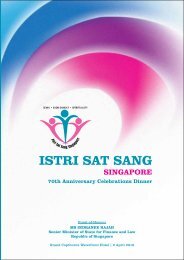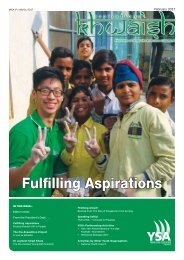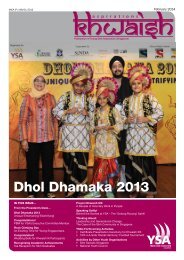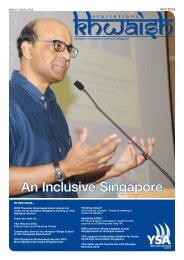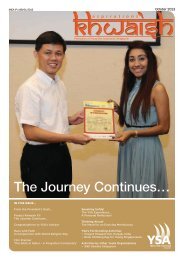Khwaish Oct 2015
You also want an ePaper? Increase the reach of your titles
YUMPU automatically turns print PDFs into web optimized ePapers that Google loves.
middle income countries; Singapore being<br />
the 8th best globally; and even Cambodia<br />
ranking fifth among the low income<br />
economies as the Conference Board (2013)<br />
estimates of total factor productivity<br />
growth shows. The challenge will be to<br />
push the process further towards a more<br />
innovative ASEAN in terms of investments<br />
in research and development, investments<br />
in human capital, and the strengthening of<br />
the policy and institutional environment<br />
for quality assurance, technology diffusion<br />
and innovation, which should figure<br />
prominently in the future plans for post-<br />
<strong>2015</strong> community building.<br />
Innovation does not exist by itself. It<br />
tends to happen in industries which are<br />
plugged to regional and global production<br />
networks. Innovation will also need<br />
financing, availability of specialised skills<br />
and services, and large integrated markets,<br />
which the AEC is creating. Technology<br />
diffusion and innovation benefit from<br />
investments and from trade-investmenttechnology<br />
nexus of production networks,<br />
which will be facilitated by FDI into ASEAN.<br />
ASEAN attracted about US$128 billion in<br />
FDI in 2013 alone, which is the highest in<br />
the history of ASEAN.<br />
Here, the small and medium enterprises<br />
(SMES) play an important role. They<br />
constitute 95 to 99 per cent of firms in<br />
the ASEAN economies. Together, they<br />
provide between 43 to 97 per cent of the<br />
employment; contribute between 23 to<br />
58 per cent to the GDP; and 10 to 30 per<br />
cent in total exports of ASEAN. Since the<br />
SMEs have a direct impact on the ASEAN<br />
economies, their competitiveness and<br />
robustness are key to building a resilient<br />
ASEAN single market. In this regard, more<br />
have to be done in strengthening SMEs,<br />
which will include improvement in human<br />
resources, provision of access to finance,<br />
technology and innovation, amongst<br />
others.<br />
Opportunities and Challenges for AEC<br />
So what are the opportunities and<br />
challenges for AEC? Recent surveys<br />
conducted by the Economist Corporate<br />
Network and the ASEAN Business Advisory<br />
Council indicate that most companies<br />
are confident that the AEC would have<br />
significant impact on their businesses and<br />
they plan to invest more in ASEAN. The<br />
multinational companies surveyed by the<br />
Economist see opportunities for short-term<br />
and long-term potentials supported by the<br />
economic growth and increasing middle<br />
income and young population. ASEAN is<br />
becoming a manufacturing hub and the<br />
region’s pent-up demand for infrastructure<br />
and other fixed assets like housing and<br />
factories is expected to spur further growth<br />
in the region.<br />
However, building the AEC is not a bed of<br />
roses. Southeast Asia is one of the most<br />
diverse regions in the world. Forging a<br />
community is, therefore, a daunting task<br />
but ASEAN has been doing this quite<br />
admirably. What will be needed would<br />
be for ASEAN to focus on implementing<br />
the remaining measures expeditiously<br />
and to focus on specific priorities such<br />
as trade integration and liberalisation;<br />
removal of non-tariff barriers to trade as<br />
well as barriers to investments; building<br />
up regional connectivity in terms of<br />
roads, railways, air and maritime links;<br />
trade facilitation especially customs,<br />
standards harmonisation and regulatory<br />
convergence; freer movement of skill<br />
labor and professionals through the<br />
implementation of existing mutual<br />
recognition arrangements and new ones;<br />
and completing the RCEP negotiations on<br />
time .<br />
Importantly too, ASEAN member states will<br />
have to transpose the regional commitments<br />
they have made in ASEAN into national<br />
obligations through their respective<br />
domestic processes and at a quicker pace.<br />
The domestic legal enactments relating to<br />
ASEAN commitments should be monitored<br />
as part of the ASEAN Scorecard process.<br />
This will help to boost the implementation<br />
of the AEC measures and bring ASEAN<br />
closer to achieving its AEC in <strong>2015</strong>.<br />
In building the AEC, the role of the private<br />
sector in ASEAN should not be underestimated.<br />
It needs to be better engaged<br />
as it is the principal driver of regional<br />
economic integration. There should be<br />
regular sector-specific dialogue with the<br />
business community so that ASEAN can<br />
address the private sector’s concerns and<br />
create a more facilitative environment for<br />
doing business in the region. More technical<br />
meetings of ASEAN in the economic arena<br />
could also be opened up to the participation<br />
of the private sector. The SMEs must be an<br />
integral of the private sector participation<br />
in the AEC and they should benefit from<br />
the progress of the AEC.<br />
ASEAN must exert more effort in<br />
narrowing the development gaps, which<br />
will significantly impact the quality and<br />
pace of ASEAN’s economic integration<br />
initiatives. While work is ongoing in this<br />
area, ASEAN is experiencing tremendous<br />
resource constraints. There has been<br />
considerable difficulty in the less developed<br />
ASEAN economies in transposing regional<br />
commitments, both intra-ASEAN and extra-<br />
ASEAN commitments, into domestic laws<br />
and regulations due to lack of capacity and<br />
financial resources. There is also a need<br />
to intensify communication efforts to the<br />
business community, especially the SMEs<br />
to keep them updated on AEC’s progress<br />
and initiatives.<br />
At the same time, ASEAN will have to work<br />
together as one single unit in addressing<br />
external challenges. In an inter-connected<br />
and interdependent world, ASEAN will not<br />
be spared from economic uncertainties<br />
from other parts of the world that could be<br />
transmitted to the region. The Chiang Mai<br />
Multilateralisation Initiative, the ASEAN+3<br />
Emergency Rice Reserve and the Regional<br />
Comprehensive Economic Partnership are<br />
some examples of how ASEAN has reacted<br />
to the external challenges. This has also<br />
helped to reinforce ASEAN’s relevance<br />
and strengthened its ability to maintain<br />
ASEAN’s centrality in the evolving and<br />
dynamic regional architecture.<br />
Conclusion<br />
ASEAN should start looking at building<br />
a people-oriented community so that<br />
community building will be sustainable as<br />
without the involvement of all stakeholders<br />
of the single market. Here, the role of the<br />
private sector must be further strengthened<br />
and new important issues like environment,<br />
food security, and energy security must be<br />
addressed.<br />
The potentials of the youth in contributing<br />
towards the ASEAN community building<br />
process must be recognised and ASEAN<br />
awareness must be encouraged through<br />
different platforms to promote sharing of<br />
perspectives and ideas as wells promoting<br />
people-to-people exchanges.<br />
In short, community building is the best<br />
option for ASEAN to be more integrated<br />
and connected so that diversity could<br />
become a real asset for the region and<br />
creativity, innovation and entrepreneurship<br />
could thrive. This is help in reinforcing<br />
ASEAN’s centrality in the evolving and<br />
dynamic economic architecture in East<br />
Asia. The best for the ASEAN single market<br />
is yet to come and it will germinate, develop<br />
and flourish in the minds and hands of our<br />
future leaders, the youth of today.<br />
Mr S Pushpanathan is the Managing<br />
Director Asia-Pacific of a global strategic<br />
consultancy, EAS Strategic Advice. He was<br />
formerly the Deputy Secretary General of<br />
ASEAN for ASEAN Economic Community.<br />
The views presented in this article are<br />
personal and do not necessarily reflect<br />
those of YSA.<br />
<strong>Khwaish</strong> 11




